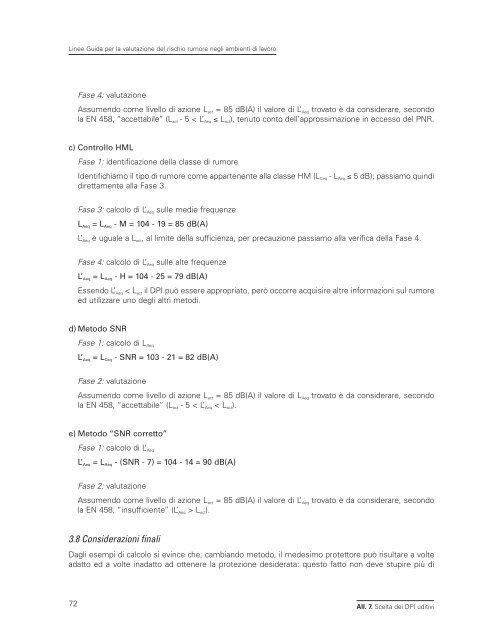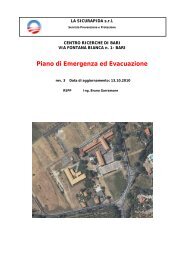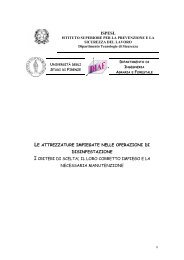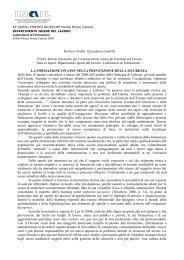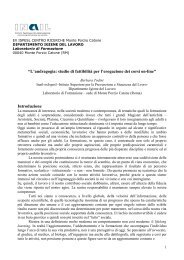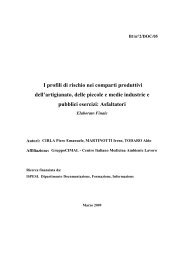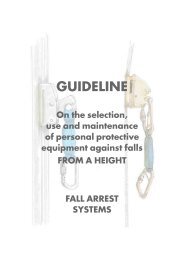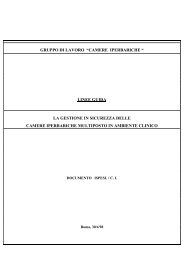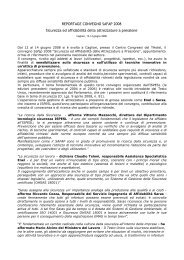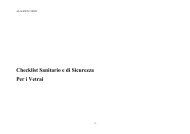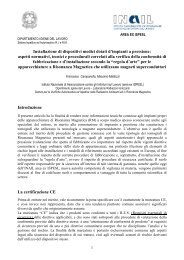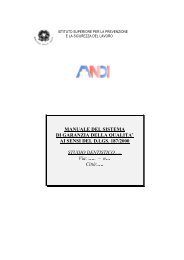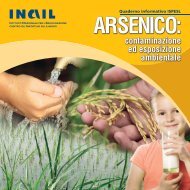LINEE GUIDA per la valutazione del rischio rumore - Ispesl
LINEE GUIDA per la valutazione del rischio rumore - Ispesl
LINEE GUIDA per la valutazione del rischio rumore - Ispesl
You also want an ePaper? Increase the reach of your titles
YUMPU automatically turns print PDFs into web optimized ePapers that Google loves.
Linee Guida <strong>per</strong> <strong>la</strong> <strong>valutazione</strong> <strong>del</strong> <strong>rischio</strong> <strong>rumore</strong> negli ambienti di <strong>la</strong>voro<br />
Fase 4: <strong>valutazione</strong><br />
Assumendo come livello di azione Lact = 85 dB(A) il valore di L’ Aeq trovato è da considerare, secondo<br />
<strong>la</strong> EN 458, “accettabile” (Lact - 5 < L’ Aeq ≤ Lact), tenuto conto <strong>del</strong>l’approssimazione in eccesso <strong>del</strong> PNR.<br />
c) Controllo HML<br />
Fase 1: identificazione <strong>del</strong><strong>la</strong> c<strong>la</strong>sse di <strong>rumore</strong><br />
Identifichiamo il tipo di <strong>rumore</strong> come appartenente al<strong>la</strong> c<strong>la</strong>sse HM (LCeq - LAeq ≤ 5 dB); passiamo quindi<br />
direttamente al<strong>la</strong> Fase 3.<br />
Fase 3: calcolo di L’ Aeq sulle medie frequenze<br />
LAeq = LAeq - M = 104 - 19 = 85 dB(A)<br />
L’ Aeq è uguale a Lact, al limite <strong>del</strong><strong>la</strong> sufficienza, <strong>per</strong> precauzione passiamo al<strong>la</strong> verifica <strong>del</strong><strong>la</strong> Fase 4.<br />
Fase 4: calcolo di L’ Aeq sulle alte frequenze<br />
L’ Aeq = LAeq - H = 104 - 25 = 79 dB(A)<br />
Essendo L’ Aeq < Lact il DPI può essere appropriato, <strong>per</strong>ò occorre acquisire altre informazioni sul <strong>rumore</strong><br />
ed utilizzare uno degli altri metodi.<br />
d) Metodo SNR<br />
Fase 1: calcolo di L Aeq<br />
L’ Aeq = L Ceq - SNR = 103 - 21 = 82 dB(A)<br />
Fase 2: <strong>valutazione</strong><br />
Assumendo come livello di azione Lact = 85 dB(A) il valore di LAeq trovato è da considerare, secondo<br />
<strong>la</strong> EN 458, “accettabile” (Lact - 5 < L’ Aeq < Lact). e) Metodo “SNR corretto”<br />
Fase 1: calcolo di L’ Aeq<br />
L’ Aeq = L Aeq - (SNR - 7) = 104 - 14 = 90 dB(A)<br />
Fase 2: <strong>valutazione</strong><br />
Assumendo come livello di azione Lact = 85 dB(A) il valore di L’ Aeq trovato è da considerare, secondo<br />
<strong>la</strong> EN 458, “insufficiente” (L’ Aeq > Lact). 3.8 Considerazioni finali<br />
Dagli esempi di calcolo si evince che, cambiando metodo, il medesimo protettore può risultare a volte<br />
adatto ed a volte inadatto ad ottenere <strong>la</strong> protezione desiderata: questo fatto non deve stupire più di<br />
72<br />
All. 7. Scelta dei DPI uditivi


